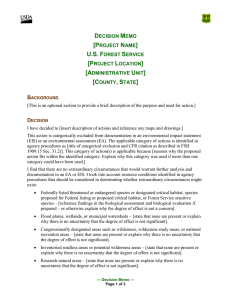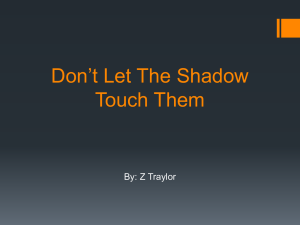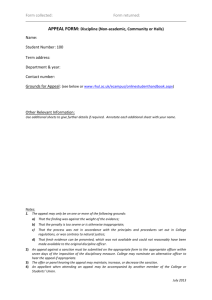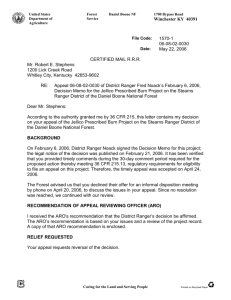The Decision Memo Template
advertisement
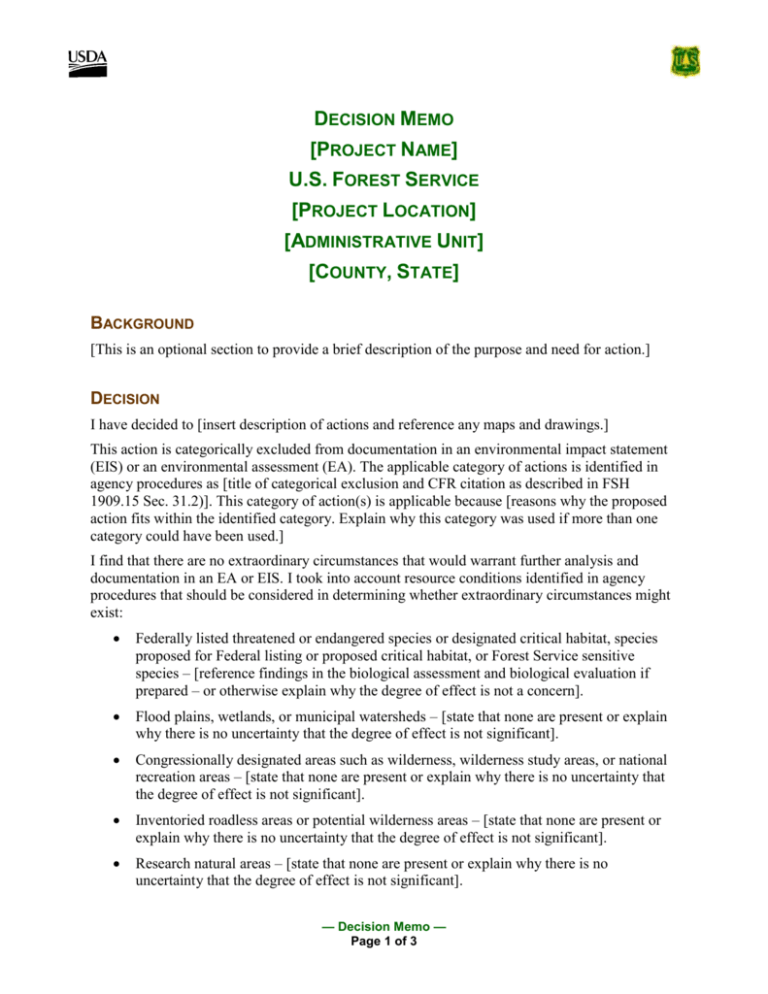
DECISION MEMO [PROJECT NAME] U.S. FOREST SERVICE [PROJECT LOCATION] [ADMINISTRATIVE UNIT] [COUNTY, STATE] BACKGROUND [This is an optional section to provide a brief description of the purpose and need for action.] DECISION I have decided to [insert description of actions and reference any maps and drawings.] This action is categorically excluded from documentation in an environmental impact statement (EIS) or an environmental assessment (EA). The applicable category of actions is identified in agency procedures as [title of categorical exclusion and CFR citation as described in FSH 1909.15 Sec. 31.2)]. This category of action(s) is applicable because [reasons why the proposed action fits within the identified category. Explain why this category was used if more than one category could have been used.] I find that there are no extraordinary circumstances that would warrant further analysis and documentation in an EA or EIS. I took into account resource conditions identified in agency procedures that should be considered in determining whether extraordinary circumstances might exist: Federally listed threatened or endangered species or designated critical habitat, species proposed for Federal listing or proposed critical habitat, or Forest Service sensitive species – [reference findings in the biological assessment and biological evaluation if prepared – or otherwise explain why the degree of effect is not a concern]. Flood plains, wetlands, or municipal watersheds – [state that none are present or explain why there is no uncertainty that the degree of effect is not significant]. Congressionally designated areas such as wilderness, wilderness study areas, or national recreation areas – [state that none are present or explain why there is no uncertainty that the degree of effect is not significant]. Inventoried roadless areas or potential wilderness areas – [state that none are present or explain why there is no uncertainty that the degree of effect is not significant]. Research natural areas – [state that none are present or explain why there is no uncertainty that the degree of effect is not significant]. — Decision Memo — Page 1 of 3 American Indians and Alaska Native religious or cultural sites – [State that none are present or explain why there is no uncertainty that the degree of effect is not significant. Cite cultural resources survey and State Historic Preservation Office concurrence if applicable. Cite tribal consultation if conducted]. Archaeological sites, or historic properties or areas – [State that none are present or explain why there is no uncertainty that the degree of effect is not significant. Cite cultural resources survey and State Historic Preservation Office concurrence if applicable. Cite tribal consultation if conducted]. [Add any other pertinent situations that were brought up during scoping for consideration and why they don’t constitute extraordinary circumstances]. PUBLIC INVOLVEMENT This action was originally listed as a proposal on the [your forest] National Forest Schedule of Proposed Actions and updated periodically during the analysis. [List any interested and affected agencies, organizations, and persons contacted. Briefly identify steps taken to inform people about the proposed action such as mailings, news releases, phone calls, etc.] FINDINGS REQUIRED BY OTHER LAWS AND REGULATIONS This decision is consistent with the [your forest] National Forest Land Management Plan. The project was designed in conformance with [land management plan direction relevant to project activities]. [Insert any findings for other applicable laws. These findings should be supported in your project record.] ADMINISTRATIVE REVIEW (APPEAL) OPPORTUNITIES [Consult your appeals specialist for applicable appeal regulations and appropriate appeal rights language.] [If the decision is also subject to appeal under 36 CFR 251, be sure to inform the applicant(s) or permit holder(s) separately of their appeal rights under those regulations.] IMPLEMENTATION DATE [Describe the expected date of implementation. If subject to appeal, the applicable appeal regulation might require a delay before implementation. Consult your appeal specialist for appropriate language.] — Decision Memo — Page 2 of 3 CONTACT For additional information concerning this decision, contact: [contact name, title, unit name, mailing address, and phone number]. [Deciding Official’s Name] Date [Deciding Official’s Title] The U.S. Department of Agriculture (USDA) prohibits discrimination in all its programs and activities on the basis of race, color, national origin, age, disability, and where applicable, sex, marital status, familial status, parental status, religion, sexual orientation, genetic information, political beliefs, reprisal, or because all or part of an individual’s income is derived from any public assistance program. (Not all prohibited bases apply to all programs.) Persons with disabilities who require alternative means for communication of program information (Braille, large print, audiotape, etc.) should contact USDA's TARGET Center at (202) 720-2600 (voice and TDD). To file a complaint of discrimination, write to USDA, Director, Office of Civil Rights, 1400 Independence Avenue, S.W., Washington, D.C. 20250-9410, or call (800) 795-3272 (voice) or (202) 720-6382 (TDD). USDA is an equal opportunity provider and employer. — Decision Memo — Page 3 of 3
